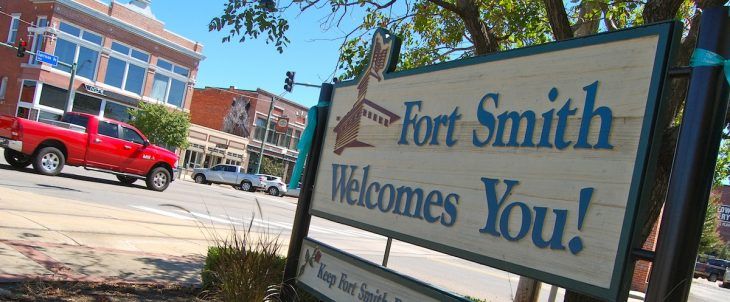Downtown Fort Smith traffic ideas to be presented in next two months
by May 23, 2019 8:02 pm 706 views

James Arbuckle, vice president with Halff Associates, reported Thursday (May 23) on a public input survey, gave an update on goals and said recommendations on what Fort Smith officials could do to help traffic downtown would be coming within the next two months.
Arbuckle, project manager of the Fort Smith Downtown Traffic and Truck Study, said they received 560 responses from the public to a downtown traffic survey. The survey had 10 multiple choice and four open-ended questions. There was also a survey sent to members of the trucking industry in Fort Smith.
The Fort Smith Board of Directors passed a resolution in November that authorized an engineering services agreement with Halff Associates of Little Rock for the Fort Smith Downtown Traffic and Truck Study. The study, not to cost more than $151,986, is based on recommendations from the Propelling Downtown Forward Plan, was adopted by the board in August 2017 as “a master plan addressing specific development and revitalization issues in the downtown and Central Business Improvement District (CBID) areas,” information on the study states.
Key findings among those completing the survey were Garrison Avenue safety issues, including vehicles running red lights and unsafe pedestrians crossings. Fifty percent of those surveyed said they did not feel comfortable or safe when walking, jogging or biking downtown, Arbuckle reported.
“Is that entirely concern for traffic or other safety concerns downtown? We do not know that,” he said, but noted that pedestrian safety and walking were mentioned roughly twice as much as the next most mentioned topic.
Research by Halff showed that from 2015-2018, most of the accidents downtown were at 11th Street and Towson or Garrison avenues; Sixth Street and Garrison Avenue; 10th Street and Garrison Avenue; Fifth Street and Garrison Avenue where Rogers and Garrison avenues converge; and Towson Avenue at Dodson Avenue and at I Street, the entrance into Baptist Fort Smith. Accidents involving pedestrians were reported at Third and Garrison, Fifth and Garrison, 10th and Garrison and Towson and I Street, Arbuckle said.
Other key findings were “local truck industry representatives share concern that designated truck routes or roadways critical to their business would be modified in such a way that would cause financial burden,” congestion along Garrison Avenue, and truck routes are not designed for easy access and non-local freight truck drivers do not follow them, Arbuckle said.
Trucking industry survey results showed that those in the industry were concerned about a protected left turn signal at Fifth and Garrison, more visible truck signage, general street repair and lighting, wider turning radii at intersections, more synchronized traffic lights and the possibility of moving the truck route to 11th Street.
When community participants were asked what traffic improvement they would like to see downtown, most of the comments were related to commercial truck traffic, he said, noting that 389 responded to the question and 104 commented about commercial truck concerns.
“Feedback regarding commercial truck traffic was related to recommendations about improving safety for people walking, improving traffic flow, and improving roadway conditions in downtown Fort Smith. The intersection of (Fifth Street and Garrison Avenue) was called out specifically as needing repair,” Arbuckle’s report said.
Arbuckle asked the group their thoughts on parking, partial closure of streets and potential impacts to existing buildings and infrastructure. The group agreed there is plenty of parking downtown, the problem was some people did not want to have to walk a couple of blocks from where they were able to park to their destination or did not like to have to pay parking meters to park.
Fort Smith City Administrator Carl Geffken said changes are expected and needed and if it’s for great improvement, sacrifices may have to be made.
“As long as it doesn’t negatively impact industry or a business or the people coming to them, if some parking has to be lost or a building has go in order to make a turn safer or something, then we have to do that,” Geffken said.
He also said he has to look out for all the players in the game, including those wanting to make downtown more vital, those building out at Chaffee Crossing and those in the central part of town, a role that puts in a more moderate mindset when it comes to downtown changes. Others attending agreed with that approach.
“I would argue that we don’t need any trucks downtown, but you can’t do that, at least not immediately,” said Rodney Ghan, a member of the working group and member of the Central Business Improvement District. “But as people come and downtown grows and flourishes, we are going to need to look at the trucks. People have concerns. We need to address their concerns.”
Arbuckle said he and his associates have some ideas that could address the deficiencies downtown and some suggestions for quick fixes. The next step in the study will be to present alternatives that address quick fixes and ones that address middle and long-term solutions. Halff will be ready to present those in another two months, he said.
Private contributions to pay part of the cost of the study total $47,000 and are broken down as follows: Central Business Improvement District (CBID ), $20,000; OK Foods, $10,000; ArcBest, $5,000; Ghan & Robinson Family Foundation, $4,000; Arkansas Refrigerated Services, $3,000; First National Bank, $2,000; Phil White, $2,000; and Davis Iron & Metal, $1,000.
